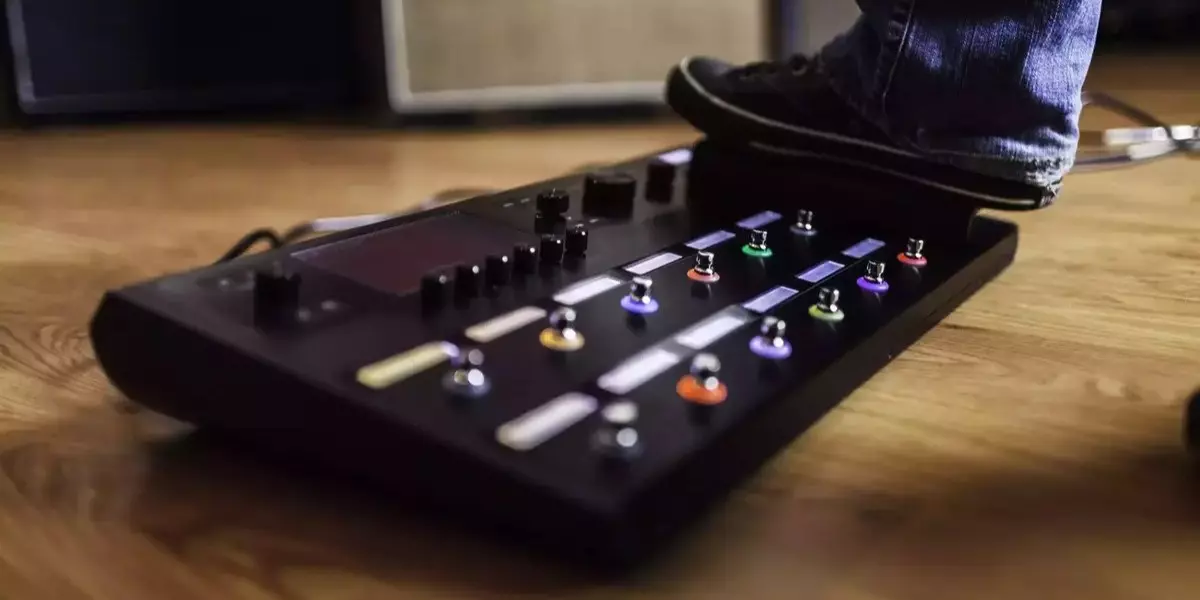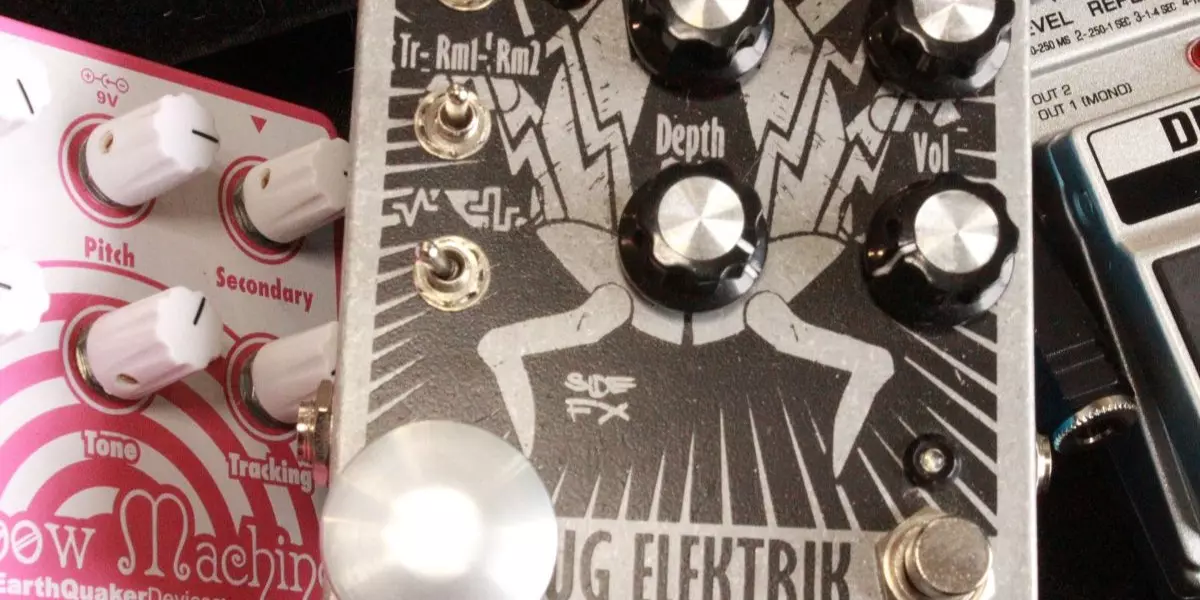Rewriting the DNA of Tone

Helix. No longer just the name of a renowned(ish) heavy metal band from Ontario (and if you haven’t seen the video for “Rock You,” then you haven’t seen a bunch of sweaty men in a pit hammering the ground for no apparent reason), the fine engineers at Line 6 have birthed the next generation of guitar processing and have named it after an ‘80s rock band. Okay, that might not be 100% true, but when you are rewriting the DNA of guitar effects, it seems apropos to name it Helix.
More than an effects pedal board, the Helix, as well as its slightly stripped down counterpart the Helix LT, is the latest in a long line of processors from the tone gurus at Line 6, and in this article I will not only explore the features of the Helix, but I’ll go over concepts like amp modeling, discuss features and how they can fit into (or completely replace) your rig, and I’ll talk about all things Helix. Again, the pedal board, not the band.
Career in Modeling
If you walk into any Long & McQuade and ask about practice amps, chances are you will hear the phrase “amp modeling.” Almost all amp companies, from Mesa Boogie to Fender, from Vox to Marshall, have their signature tone. In an extremely broad sense, there is an American sound, which tends to be clear, glassy and more mid-scooped (like Fender), and a British sound, which tends to be more throaty with a mid-range bark (like Marshall). When a company like Line 6 “models” an amp, it basically takes the core tone, the essence/spirit of those iconic tones, takes a digital snapshot of that tone and loads it into the amp. While modeling amps offer an incredible variation of tones for an unbeatable value, the question is...do the amp models really sound like the actual amp they are modeling in the first place? Enter Helix.
Styling and Profiling
Just like the DNA molecule, woven in its double helix pattern, the Helix pedal is all about evolution, only in this case it’s the evolution of modeling and tone rather than the code that tells cells what to do. Didn’t think you’d get a little science lesson in the middle of this article, did you?
What Line 6 has done with their Helix pedals is called component modeling. What that means is that within its signal processor, every component of an amp circuit has been copied and loaded into the Helix. From capacitors and potentiometers to resistors and transformers, all of the internal parts of an amp’s signal flow are carefully copied, digitally.
Without getting too technical, the end result is that the Helix “creates” the tone using all of these digital components, just like a real amp would. Because of this, the amp sound that you hear from the pedal “feels” like a real amp and reacts (or behaves) like a real amp would too. For example, when you roll back the volume on your guitar (if you are plugged into a traditional rig), you expect the tone to become not only quieter but cleaner as well. With previous and more entry level multi-effect boards, the tone simply becomes more quiet and lacks dynamics. With Helix, as you turn down your volume, it reacts just like an amp would; you can control the gain, dynamic and volume using your guitar.
We usually use the phrase “amp profiling” to describe this ultra-realistic, ultra-advanced amp modeling. Wanna add amp hum to the signal to make it sound even more authentic? Not only can you add hum to the signal, you can adjust exactly how much. Want to add so-called “squishiness” to your amp? Go right ahead. Or take it out. The choice is yours!
Line 6 has really gone the extra mile with its modeling. Within this virtual tone world where digital amps exist in a Wachowski-style Matrix, you can not only choose an amp model, but you can match it with the virtual speaker cabinet of your choice (with your choice of speakers too!) In addition, Line 6 has also mimicked the process of miking the cabinet, and if you haven’t already guessed, you get tonnes of options for virtual micing, such as type of mic (ribbon, dynamic or condenser) brand of mic (models of Shure SM57s, Sennheiser MD421s, and Neumann U87s) and even the distance from the cabinet. Clearly, the tone hounds at Line 6 went the extra mile in allowing guitarists ultimate control over their tone, but we haven’t even scratched the surface of just what this unit is capable of. Unfortunately, my word count tells me that I better move on with how to apply this pedal in real life as opposed to the virtual world we’ve inhabited for the last few paragraphs.
Pragmatic Purposes
In recent years, a new style of rig has been gaining popularity - the all-in-one processor. At one point in history you needed an amp, a pedal board and a rack the size of a Star Destroyer full of processors to even approach a professional sounding tone. With the Helix, you can literally show up at your gig with the thing under your arm and plug it directly into the PA system using the stereo XLR jacks on the back. As mentioned above, because of the enhanced processing power that it affords you, the Helix will sound and feel just as if you were playing with a real tube amp on stage.
You may be thinking to yourself, “Self, I have a favourite overdrive pedal. If I buy the Helix I won’t be able to use it anymore.” Well, the Line 6 engineers have your back yet again (but you might want to see someone about that whole “talking to yourself” thing.) The Helix has four external effects loops that allows you to patch in your preferred pedals, and it further allows you to put them anywhere in your virtual effects chain (like an overdrive before the amp, or a reverb after the amp.)
If you are more of a purist and still want to play through a real amp, the Helix can function as an excellent effects processor. You can make patches to your heart’s delight, or use the two banks of factory presets. However, don’t expect the names of the patches to inform you as to what the patch will sound like. There is a patch named Wookie Sponge Bath. I kid you not. If that weren’t enough, there is a whole online community of patch programmers and you can browse their creations and download the best of them for free. I looked up “Jimi Hendrix” and there were 15 pages of patches. In theory, if you play in a cover band, you could download patches not only for specific bands, but specific songs.
If you know someone who needs to be dragged, kicking and screaming, into the 21st century when it comes to gear, or if you yourself want a gig-worthy processor that will fit in a backpack, or if you just REALLY like the band Helix, I’d say stroll down to your local Long & McQuade and try one out. It is even available to rent. However, I must insist that you yell, right into the face of the employee that is looking after you, “Gimme an ‘R’!” Unless it’s me.
The Helix (sku 444800) an be found here. The Helix LT (sku 501559) can be found here.
**
Ian James is a lifelong lover of writing, recording and performing music, and has been working for Long & McQuade Langley and then Richmond for a total of 6 years.








